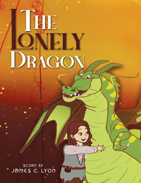
 |
There once was a fearsome dragon living in a mountain cave with a huge pile of gold and riches. He used to get tons of pleasure out of admiring the beauty of his treasures, but lately, he had been feeling sad and alone. In the valley at the foot of the mountain, there was a small village. Its inhabitants lived in poverty and were always hungry. Years ago, the dragon had stolen all their gold and riches, leaving them without the means to buy food and provisions from the king. Olyn, a young boy who lived in the village, decided that someone needed to do something about the town’s situation. It was a long hike, and Olyn was weak and hungry, but his determination carried him to the dragon’s cave. The dragon terrified Olyn, but he overcame his fear and showed great insight, asking the dragon if he ever felt lonely. This conversation led to the dragon accompanying the boy to the village, where he was treated warmly and hugged by Olyn. The dragon enjoyed the feeling of community and decided to share his treasure, which allowed the villagers to purchase goods again from the king.
Picture books with dragons have maintained a solid fan base through the years. The genre has seen offerings from writers such as Jane Yolen, Robert Munsch, and Lenny Lipton. Lyon’s book follows in the footsteps of these well-established children’s authors. For example, those who have read extensively in the genre may recognize themes in Lyon’s book that are similar to those in others, such as Mark Sperring’s The Sunflower Sword. In this case, both books feature a child protagonist who overcomes their own personal fear in order to confront a dragon. Books such as these emphasize two opposing forces that are at odds and openly hostile. However, each group has something which will help the other. In these tales, people benefit after conquering their fears and approaching the dragons with conversation instead of combat. In turn, the dragons are hungry for fellowship and companionship and build a relationship with the neighboring humans to fill that need. Books such as Lyon’s serve as excellent resources for talking with young children about themes such as communication, assumptions, fear, and friendship.
With its big, bright illustrations and descriptive sentences, Lyon’s book will work well as a read-aloud for bedtime and story times. The main conflict is one that kids will understand, and the themes are broad enough to allow good discussions at many young skill levels. Some of the sentences are a bit too heavy with descriptions to maintain clarity. Overall, though, the writing works well, and the introduction of a few advanced vocabulary terms without overwhelming children is an excellent way to help improve a child’s vocabulary and reading readiness. A note of subtle irony that some astute readers might pick up on in the book is that while the dragon was hoarding resources needed by the impoverished village, so too was the king. Ultimately, Lyon offers the reader a solid title they can feel confident adding to their personal library or shared collection.
Next Focus Review
Previous Focus Review